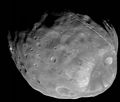Файл:Phobos colour 2008.jpg

Алдан карауның зурлыгы: 636 × 600 нокта. Башка ачыклык: 255 × 240 нокта | 509 × 480 нокта | 815 × 768 нокта | 1086 × 1024 нокта | 2172 × 2048 нокта | 3500 × 3300 нокта.
Төп файл (3500 × 3300 нокта, файл зурлыгы: 2,72 Мб, MIME төре: image/jpeg)
Файл тарихы
Файлның нинди булганлыгын күрү өчен «дата/вакыт» дигәненә басыгыз.
| Дата/вакыт | Кече рәсем | Үлчәмнәре | Кулланучы | Искәрмә | |
|---|---|---|---|---|---|
| агымдагы | 2 апр 2018, 03:10 |  | 3500 × 3300 (2,72 Мб) | Kaldari | more margin on right side |
| 13 ноя 2008, 04:47 |  | 3374 × 3300 (2,7 Мб) | Fir0002 | == Summary == {{Information |Description=Colour image of Phobos, imaged by the Mars Reconnaisance Orbiter in 2008 |Source=NASA |Date=9 April 2008 |Location=http://www.nasa.gov/mission_pages/MRO/multimedia/pia10368.html |Author=NASA/J |
Файлны куллану
Әлеге файл киләсе битне куллана:
Файлның гомуми кулланышы
Әлеге файл аста бирелгән викиларда куллана:
- af.wikipedia.org проектында куллану
- an.wikipedia.org проектында куллану
- ar.wikipedia.org проектында куллану
- المريخ
- فوبوس
- قمرا المريخ
- ويكيبيديا:صور مختارة/الفضاء والكون/نظرة إلى الأعلى
- قائمة أجرام المجموعة الشمسية مرتبة حسب الحجم
- بوابة:علم الفلك/صورة مختارة
- بوابة:المريخ/مقالة مختارة/أرشيف
- بوابة:المريخ/مقالة مختارة/2
- قائمة الأقمار الطبيعية
- خط زمني لاكتشاف كواكب المجموعة الشمسية وأقمارها
- ويكيبيديا:ترشيحات الصور المختارة/القمر فوبوس
- ويكيبيديا:صورة اليوم المختارة/أغسطس 2019
- قالب:صورة اليوم المختارة/2019-08-03
- بوابة:علم الفلك/صورة مختارة/73
- معسكر قاعدة المريخ
- استكشاف الأقمار المريخية
- ويكيبيديا:صورة اليوم المختارة/يناير 2022
- قالب:صورة اليوم المختارة/2022-01-04
- ary.wikipedia.org проектында куллану
- arz.wikipedia.org проектында куллану
- as.wikipedia.org проектында куллану
- azb.wikipedia.org проектында куллану
- az.wikipedia.org проектында куллану
- be-tarask.wikipedia.org проектында куллану
- be.wikipedia.org проектында куллану
- bg.wikipedia.org проектында куллану
- bh.wikipedia.org проектында куллану
- bn.wikipedia.org проектында куллану
- bn.wikibooks.org проектында куллану
- bs.wikipedia.org проектында куллану
Бу файлның гомуми кулланышын карау.





